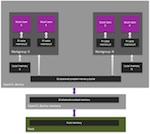|
Dear Colleague,
GPU-based vision processing acceleration via the OpenCL
API framework and other heterogeneous computing toolsets, discussed
in the first two in a series of technical articles written by
Imagination Technologies, represents one of the notable recent
additions to the Alliance website. Check out “The
Complete Glossary to Heterogeneous Compute” and “A
Primer on Mobile Systems Used for Heterogeneous Computing,” and
keep an eye on the site for more writeups to come in the coming weeks.
The Alliance has also published several new technology and
product demonstration videos in the past several weeks, the latest in a
growing abundance of such content. See, from May’s Embedded Vision
Summit, Avnet’s
demonstration of face analytics, and videantis’
demonstrations of structure from motion, pedestrian detection, and face
detection. And from last month’s Alliance Member Meeting, take a
look at Kishonti’s
demonstration of its ADASWorks 360-degree Intelligent Surround View
System. Demos are useful both in proving the practical feasibility
of concepts covered in tutorials, and in sparking your imaginations as
to how you might employ these concepts in your own designs.
The Alliance also regularly provides market research data for
embedded vision markets, along with pointers to market research reports
and firms that can supply you with more in-depth data and analysis.
Just in the past month, we’ve published analysis summaries on the 3D
imaging and facial
recognition markets from Markets & Markets, on the hyperspectral
imaging market from Micro Market Monitor, and on the broader
computer vision market from Tractica. For timely notification of
the publication of new
market analysis data and other website content, subscribe to our RSS feed and Facebook,
Google+,
LinkedIn
company and group,
and Twitter social
media channels.
Thanks as always for your support of the Embedded Vision
Alliance, and for your interest in and contributions to embedded vision
technologies, products and applications. Please don’t hesitate to let me know how the
Alliance can better serve your needs.
Brian Dipert
Editor-In-Chief, Embedded Vision Alliance
|
|
“Introducing the IEEE Low-Power Image Recognition Challenge (LPIRC),” a Presentation from Purdue University
Yung-Hsiang Lu, Associate Professor at
Purdue University, delivers the presentation “Introducing the IEEE
Low-Power Image Recognition Challenge (LPIRC)” at the September 2015
Embedded Vision Alliance Member Meeting. Yung-Hsiang describes the
objectives and details of the competition, the 2015 LPIRC results, and
the upcoming 2016 LPIRC plans. In an upcoming article on the website,
the Alliance will interview the members of one of the winning 2015
LPIRC teams, from the Electrical Engineering Department at Tsinghua
University Beijing, China.
Basler’s Thies Möller Answers the Question, “What is a Vision System?”
When it comes to industrial image
processing, there are many tasks, from quality controls to sorting
foods, that require more than just one single camera. Responsibilities
like these require a more comprehensive image processing system, known
as a vision system. The camera is the centerpiece of the vision system,
which is not to say that the other components in the system are not
important. Thies Möller, Technical Architect at Basler AG, details the
most important components of this kind of system and explains how it is
structured and what advantages it offers. Using a cookie as his sample
product, he explains in more detail just how a vision system works.
Enjoy the delicious lesson.
More Videos
|
|
OpenCL Streamlines FPGA Acceleration of Computer Vision
The substantial resources available in
modern programmable logic devices, in some cases including embedded
processor cores, makes them strong candidates for implementing
vision-processing functions. The rapidly maturing OpenCL framework, as
discussed in detail in this technical article co-authored by Altera,
Auviz Systems and Xilinx, enables the rapid and efficient development
of programs that execute across programmable logic fabric and other
heterogeneous processing elements within a system. More
The Memory Bandwidth, Stupid!
“The economy, stupid” was one of the
phrases that strategist James Carville hung on a sign in Bill Clinton’s
1992 presidential campaign headquarters, a reminder to focus on what’s
most important. In a similar vein, the reminder “It’s the memory
bandwidth, stupid” should probably be prominently displayed wherever
computer vision software developers work. It has recently become
feasible to implement sophisticated computer vision algorithms on
embedded and mobile processors, which enables functions as diverse and
face recognition, collision avoidance and automated inspection. But
“feasible” doesn’t mean “easy.” More
More Articles
|







